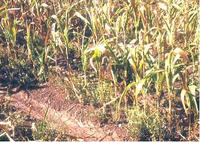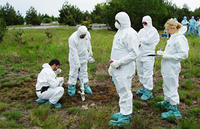-
Kansas State takes over pathogen research from Plum Island
As New York’s Plum Island Animal Disease Center begins to shut down, much of its pathogen work will be transferred to Kansas State University’s Biosecurity Research Institute in preparation for the opening of DHS’ new National Bio and Agro-Defense Facility (NBAF) in nearby Manhattan, Kansas
-
-
Delicate balance: scientific freedom and national security
Two legal scholars argue that the U.S. government’s request that the journals Science and Nature withhold scientific information related to the genetically modified H5N1 virus because of biosecurity concerns does not violate the First Amendment
-
-
Chicago's new bio-attack response facility

Chicago is preparing itself for a biological attack with the recent unveiling of a new 40,000 square-foot, fourteen story state-of the-art medical decontamination facility; the new facility is fully equipped to handle a sudden influx of patients from a biological attack or other mass casualty incident
-
-
Budget cuts hamper U.S. response to biological attack
A recently released report charges that state and federal budget cuts have weakened U.S. bioterrorism response capabilities
-
-
How the bioweapon ricin kills
Ricin is one of the deadliest plant based poisons in the world, and what makes it especially dangerous is that it comes from the humble castor oil bean and is available in many health food shops or online; scientists discover the protein that controls how ricin kills
-
-
Detecting botulinum toxin
A company specializing in molecular diagnostic tests based on Single Molecule Array (SiMoA) technology has been awarded a contract from DHS to develop an assay capable of detecting single molecules of botulinum toxin (BoNT) within complex environmental samples
-
-
U.S. unprepared for biological attack
The United States is inadequately prepared to respond to a biological attack and there are several severe weaknesses in its defense capabilities. According to a New York Times investigative report, funding issues, competing agencies with different priorities, and an overall lack of urgency have contributed to a situation where the U.S. lacks countermeasures to combat a number of biological agents that could be used in an attack
-
-
Alien species: a dangerous new bioterrorism threat

Federal counterterrorism officials have a potentially catastrophic new threat to worry about – invasive alien species; the threat is so serious, Lawrence Roberge, an associate professor of anatomy and physiology at Laboure College, warned that terrorists could seek to use invasive species as biological weapons
-
-
Research into bird flu raises bioterrorism fears
In order to stay ahead of H5N1, scientists have been tweaking the virus’s genes in the lab to learn more about how this virus works and what it is capable of; in the process, these scientists made the virus more virulent and more contagious; now, security experts and scientists debate whether or not to make the results of these recent experiments public; security experts say doing so could potentially reveal how to make powerful new bioweapons.
-
-
New testing capabilities for bioterror threats
Research presented at the 13th Medical Biodefense Conference in Munich says that Abbott’s PLEX-ID system provides reliable and rapid results for key microbial biothreat agents and should be considered as a first line analytical tool for biodefense, biosecurity, and microbial forensics programs
-
-
Natural killer cells may be the best defense against anthrax
One of the things that makes inhalational anthrax so difficult for biodefense experts to deal with is the speed with which a relatively small number of inhaled anthrax spores can turn into a lethal infection; by the time an anthrax victim realizes he or she has something worse than the flu, it is often too late
-
-
U.S. is not ready for bioterror attacks
Since 9/11, the U.S. government has spent more than $60 billion of bolstering U.S. defenses against a terrorist attack using biological agents. The money paid for air sensors in major cities, intensified efforts to develop vaccines and treatments for anthrax and other potential biotrerror weapons, educating doctors about bioterror attack symptoms, distributing equipment to hospitals around the country, and more. Still, even within the biodefense community, there is a wide-spread belief that these measures have not made the United States meaningfully less vulnerable to a bioterror attack.
-
-
Government considers testing anthrax vaccine on children

The U.S. government is considering testing its anthrax vaccine on children to determine if it has any potential side effects; so far the government’s anthrax vaccine has only been tested on adults and members of the National Biodefense Science Board argued that there had been no tests to determine the effectiveness of the vaccine on children; opponents of the suggestion have sharply criticized it on the grounds that it is unethical to test a vaccine on children especially if there is no immediate threat; proponents of testing the vaccine acknowledged the criticism, but maintained that it was critical to ensure the safety of the vaccine on children in the event that it had to be administered; the board is set to meet again on Friday to vote on its controversial recommendation
-
-
DHS funds Ricin detection
Positive ID announces the company’s immunodetection assay for the identification of Ricin toxin to meet DHS specifications; Ricin, a chemical warfare agent, is derived from the seeds of the castor oil plant Ricinus communis and has become a tool of terrorist groups across the world due to its easy production and high toxicity
-
-
U.S. unprepared for large-scale bio-attack, report warns

On Wednesday, the WMD Center released its latest report that found the United States is unprepared for a large-scale biological attack, despite spending more than $65 billion on biodefense over the past decade; the report warned that the threat of biological weapons is now greater than ever as a result of technological advances; a small team of individuals with training in key disciplines can produce “the type of bioweapons created by nation-states in the 1960s”
-
- All
- Regional
- Water
- Biometrics
- Borders/Immig
- Business
- Cybersecurity
- Detection
- Disasters
- Government
- Infrastructure
- International
- Public health
- Public Safety
- Communication interoperabillity
- Emergency services
- Emergency medical services
- Fire
- First response
- IEDs
- Law Enforcement
- Law Enforcement Technology
- Military technology
- Nonlethal weapons
- Nuclear weapons
- Personal protection equipment
- Police
- Notification /alert systems
- Situational awareness
- Weapons systems
- Sci-Tech
- Sector Reports
- Surveillance
- Transportation
Advertising & Marketing: advertise@newswirepubs.com
Editorial: editor@newswirepubs.com
General: info@newswirepubs.com
2010-2011 © News Wire Publications, LLC News Wire Publications, LLC
220 Old Country Road | Suite 200 | Mineola | New York | 11501
Permissions and Policies
Editorial: editor@newswirepubs.com
General: info@newswirepubs.com
2010-2011 © News Wire Publications, LLC News Wire Publications, LLC
220 Old Country Road | Suite 200 | Mineola | New York | 11501
Permissions and Policies
